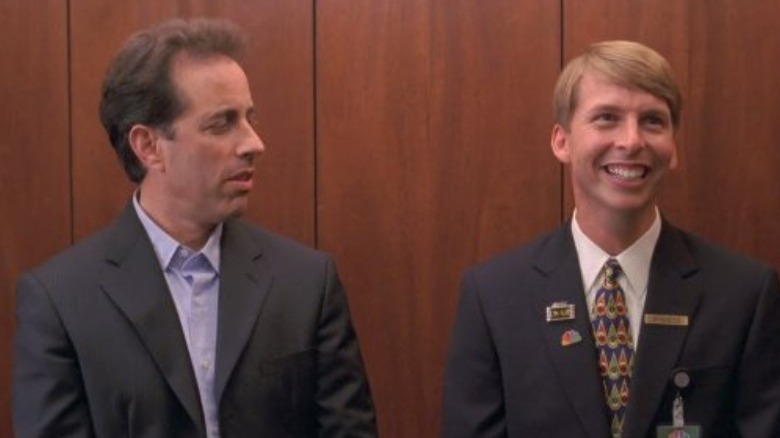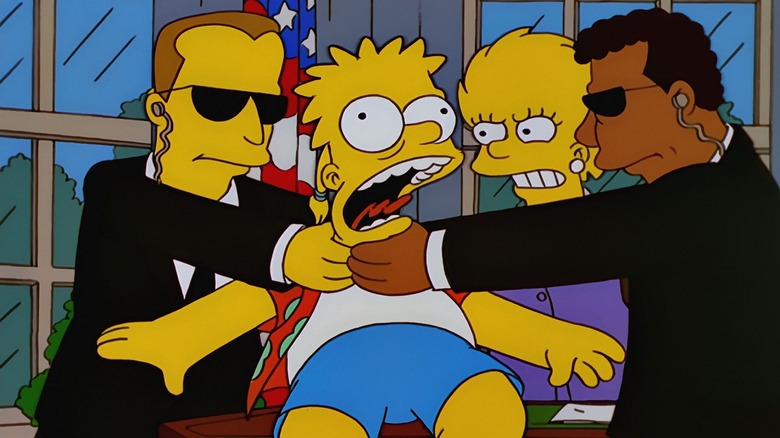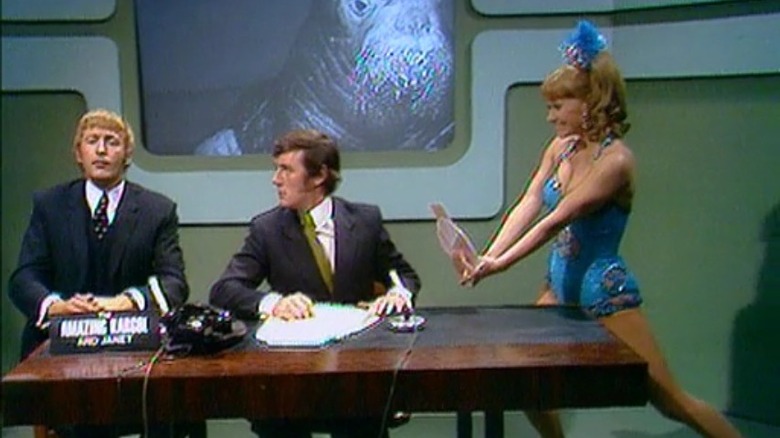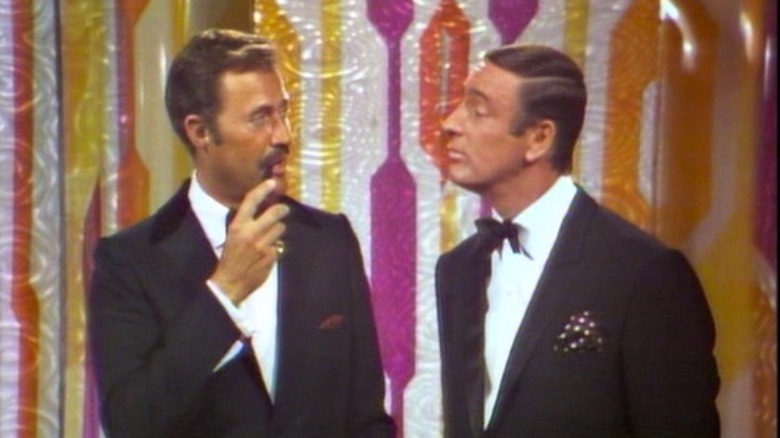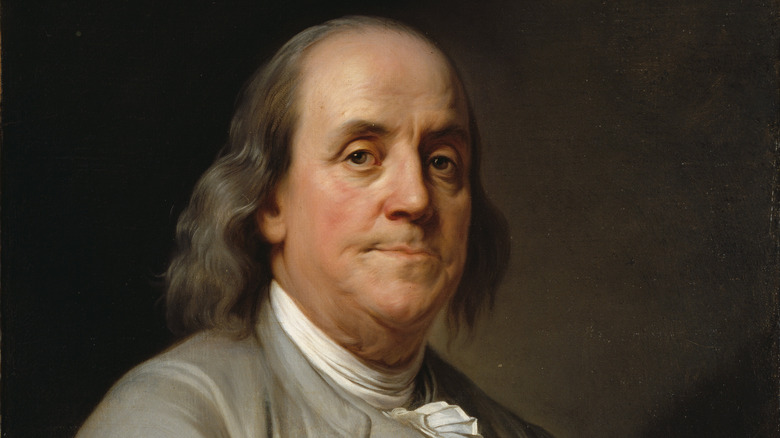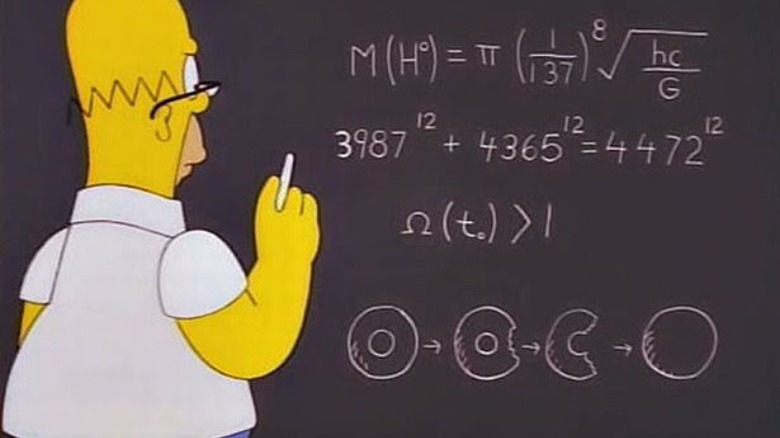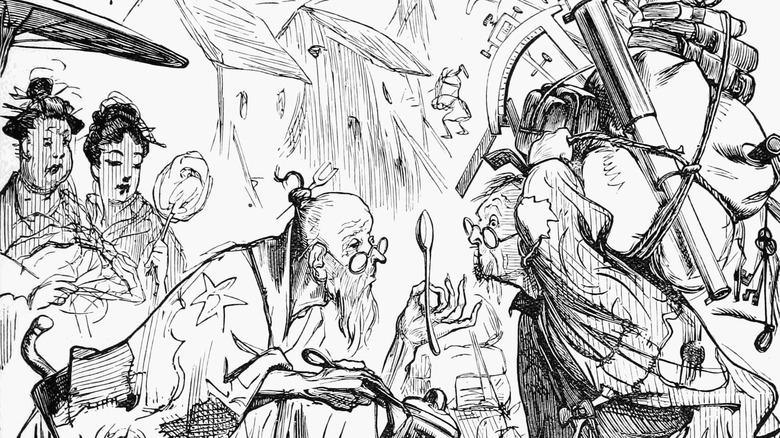Jokes That Predicted The Future
While the darker satire of dystopian writings such as Orwell's "1984," Huxley's "Brave New World," and Bradbury's "Fahrenheit 451" is often remarked upon as having reflections within developments of the modern world, it's not only the serious warnings of works like this that have come true. Nearly as often, people making jokes have turned out to be eerily prescient, proving that sometimes it's impossible to go too absurd when satirizing human behavior.
While it's often tempting to attribute oracle-like precognitive abilities to certain works of satire such as "The Simpsons," The Onion, or "30 Rock," the fact is that the writers of these works are just astute observers of humanity, and society has a tendency to live down to our worst expectations. That said, here are some examples in which a humorist said, "Things could never get this bad," and reality said, "I'll see you and raise you."
30 Rock saw the future of deepfakes
NBC's "30 Rock" was a spoof of a "Saturday Night Live"-esque sketch show but managed to get in a lot of jabs at popular culture as a whole, including–and maybe even especially–their home network NBC, which was the least watched broadcast network during the run of "30 Rock." As a result, many of the jokes centered around NBC executive Jack Donaghy's pandering attempts at creating lowest common denominator programming that would catch the audience's attention. In the 2007 episode "SeinfeldVision," Jack has the realization that NBC owns the archives to "Seinfeld," one of the network's most popular shows of all time, and so he plans to use digital technology to insert Jerry Seinfeld into every then-current NBC show in hopes it will up the ratings.
The idea of using computer generated imagery to insert uncanny valley digital versions of real people based on archival footage into movies and TV shows has become an ever-increasing reality, thanks to AI tools such as deepfakes, which use computer learning to replace one face with another. Similarly, big budget movies have used CGI to literally bring actors back from the dead, such as 2016's "Rogue One" resurrecting Peter Cushing's character from the original "Star Wars" decades after the actor himself had died. At this rate, we're not far from dead or retired actors being inserted into any show or movie a desperate, Jack Donaghy-like executive chooses.
The Simpsons foresaw the Trump presidency
One show that has gained a prominent reputation as a Nostradamus-like predictor of grim futures is "The Simpsons," but honestly, just based on the volume of jokes they've made in the last 30 years alone, they're bound to get one right every once in a while. One episode that has been noted in a number of internet memes as being particularly prophetic is the episode "Bart to the Future" from 2000, in which the titular family visits an Indian casino and the manager there tells Bart about what will happen to the family 30 years into the future. It's revealed that Bart will grow up to be a failed musician, living in a shack with Ralph Wiggum and growing ever more envious of his younger sister Lisa. Lisa, the overachiever, has managed to land the office of president of the United States, of course. The plot centers around Bart trying to tank President Lisa's popularity, but that's not the prophetic part.
While in office, Lisa talks about how her main job is to fix the economy after it was tanked by the previous president, Donald Trump. Of course, Donald Trump did become president in 2016 and, well, the economy did what it did. Episode writer Dan Greaney told the Hollywood Reporter that the joke was meant as a warning to American viewers, "the logical last stop before hitting bottom ... consistent with the vision of America going insane."
The Onion knew Gillette would do five blades
The Onion is a long-running satirical newspaper-turned-website that is often so sharp and cutting with its observations that it's not uncommon for people–even people who should know better–to be fooled by their articles. As a result of their typically astute analysis of human behavior, it's not at all uncommon for jokes in The Onion to eventually materialize in reality. One notable example of this is the 2004 faux editorial by a fictional version of the president of Gillette in which he boldly asserts, "F**** Everything, We're Doing Five Blades." At the time, the shaving razor market was getting increasingly competitive, and their main strategy for drawing in customers was adding more blades and "cooling aloe strips" or whatever to the razor. In 2004, razors with two or three blades were incredibly common, but five just seemed beyond the pale.
Except, of course, that they did f*** everything and do five blades. Barely a year after The Onion's editorial was published, Gillette announced the Fusion, a five-bladed razor with lubricating strips on both sides, a step up from its previous entries into the razor market, the three-bladed Mach3 Turbo and their competitor Schick's four-bladed Quattro. Considering the timeline of the announcement and the fact that the Fusion had five blades and two strips just like the satirically prescient version, it makes you wonder if someone at Gillette had The Onion in their bookmarks.
Monty Python accidentally predicated furries
In the late 1960s, bold civil actions such as the Stonewall Riots in June 1969 forced mainstream Western society to face the issue of the existence of the LGBTQ community and reckon with the forthcoming movement toward gay liberation. The emergence of visibility of LGBTQ individuals and communities meant media coverage of these communities and their pursuance of equality and acceptance. Such media coverage was spoofed in the second episode of "Monty Python's Flying Circus" in a sketch called "The Mouse Problem" from October 1969. The sketch is formatted like a news expose about the secret lives of men who want to be mice. The satire hits on different notes of society's reactions to the mainstreaming of homosexuality, including the moral outrage from some people, the need for secrecy, and the tendency of the media to portray the gay lifestyle as "deviant" and sensationalized.
While this sketch was definitely meant to be a thinly veiled reference to news coverage of the gay community (written by Graham Chapman, who was himself gay), in hindsight, some viewers have looked at "The Mouse Problem" as presaging the emergence of the furry community in the 1980s. Wikifur notes that the jokes written to lampoon how the media demonized homosexuality by unfavorably comparing it to crimes like arson and murder reflect modern exposes on furries.
Also, there's the fact that the sketch is about humans who dress as animals.
Laugh-In on the Berlin Wall and President Reagan
Before "Saturday Night Live," the most popular sketch comedy show in America was "Rowan and Martin's Laugh-In," a spoof of late '60s America that first made folks like Goldie Hawn and Lily Tomlin into stars and that would inspire later shows like "The Muppet Show" and "You Can't Do That On Television." One of the recurring bits on the show was "Laugh-In Looks at the News," which was a parody of network news broadcasts and which included not only current events, but also news of the past and the future. As The Virginian-Pilot explains, a couple of these "news from the future" segments were especially prescient. One episode from 1969, reporting on news from 20 years in the future, correctly predicted that East Germany would tear down the Berlin Wall in 1989. A mark against the joke, however, comes from the fact that they did not, as predicted, replace the wall with a moat full of alligators.
Perhaps more notably, an episode from 1968 made a joke about Ronald Reagan being president in 1988. While the idea of a Reagan presidency wasn't totally off the wall at the time–Reagan was then governor of California–the joke was met with so much laughter from the live audience that the announcer had to pause for it. In 1968, the idea of Reagan as president was just as laughable as Trump being president on "The Simpsons" in 2000.
Chappelle's Show traded spouses before Fox did it for real
In a key example of underestimating just how low the common denominator can go, a 2003 episode of "Chappelle's Show" featured a sketch called "Trading Spouses," which was a parody of the then-hugely popular home renovation show "Trading Spaces." The sketch was intended not only as a jab at the absurdity and prurient pandering of reality television, but also a look at racial relations. The premise was that a Black father and a white father (both played by Dave Chappelle) exchanged families, highlighting the differences in life in America for Black and white families, with the white father being extremely square (and a closet pervert) and the Black father being aggressive and crass.
In 2004, life imitated art when "Trading Spouses: Meet Your New Mommy" debuted on Fox, not only living down to the satire of the "Chappelle's Show" sketch but even using the same title. The premise was slightly different in that it was moms who exchanged families and not fathers, but otherwise the execution was very similar, including generally featuring families of different races or social classes. If one TV show based on this premise seems absurd, guess what: there were actually two shows with the same concept running at the same time. ABC's version of the idea was called "Wife Swap," which ran for a staggering 124 episodes plus a celebrity spin-off and a remake.
The Onion knew Pope Francis would be called out for being too nice
When Jorge Mario Bergoglio became Pope Francis in 2013, he was noted for his differences from his predecessors, most especially in his informal style, openness, and seemingly progressive stances on certain issues, including tolerance toward the LGBTQ community and other marginalized members of society. To that end, The Onion was quick to satirize the way the more conservative and traditional members of the Church might react to these seemingly more "liberal" statements with the headline "Vatican Quickly Performs Damage Control on Pope's Tolerant Remarks" in July 2013. The article goes on to say that spokespeople for the Vatican were quick to point out that the Pope's off-the-cuff remarks were taken out of context, and that the Pope would never officially state that his intention was for the Catholic Church to become a more "open-minded, more sensible organization" that says that "all people of good will who seek the Lord, especially gay people, should be accepted by Christ." The spokesperson concludes by assuring that the Church is "just as prejudiced and backward today as we were yesterday."
Less than three months later, the Associated Press released a story with the headline, "Pope Francis' Controversial Remarks Prompt Vatican 'Damage Control,'" and guess what? It's pretty much exactly like The Onion joked: Vatican officials assure that the Pope was just joking when he went off-script and said he wouldn't judge gay people.
Ben Franklin jokingly invented daylight saving time
Depending on whether you're a morning person or a night owl, the onset of Daylight Saving Time every year, marked by "springing forward" one hour, is either a sweet sunshiny relief or a dreaded hour-devouring bane. Long before countries began officially adopting the practice on a wide scale in the early 20th century, American inventor and humorist Benjamin Franklin suggested a similar idea in a satirical letter to the Journal of Paris in 1784. According to The Franklin Institute, Franklin was in no way actually trying to institute a new practice, but rather was jokingly suggesting that Parisians could save money on candles if they woke up an hour earlier during the summer. The whole endeavor was a tongue-in-cheek stab at the Parisian fashion to stay up late and sleep in.
However, while Franklin was poking fun, the New Zealand entomologist George Hudson was not joking at all over a century later when he suggested moving the clocks ahead two hours in the spring. As National Geographic explains, though, he wasn't trying to save on energy costs; he wanted more sunlight to hunt bugs. It was energy costs, however, that ultimately led to the installation of the practice by numerous countries starting with the German Empire in 1916. The United States picked it up in 1918 and continues with it to this day, though the time change actually no longer saves energy.
Infinite Jest presaged Trump's border wall
David Foster Wallace's exceptionally beefy 1996 novel "Infinite Jest" has become something of a meme in recent years, exemplifying the type of book that is owned and prominently displayed–but not actually read–by a certain type of boring white dude that you should probably never date.
Whether you agree with that assessment or not, the book is replete with prescient satire about modern capitalist culture, including the idea of each year having a corporate sponsor and, perhaps most notably, the election of a celebrity political outsider to the office of President of the United States. Wallace's character is Johnny Gentle, an entertainer with no political experience who rises to office on the back of cartoonishly ridiculous campaign promises that were lapped up by an angry American electorate. If that sounds familiar, we should note that one of Gentle's tentpole policies–in the search for a convenient political "other"–is building a border wall between the United States and Canada to turn a portion of the country into a hazardous waste dump and even forcing Canada to pay for the wall.
Perhaps needless to say, some "Infinite Jest" readers have been struck by the similarity between Johnny Gentle and former US President Donald Trump, a real estate person and reality show haver, who campaigned heavily in 2016 on the promise to build a border wall not with Canada, but the US's other neighbor Mexico, and to make them pay for it.
Homer Simpson's eerily close calculation of the Higgs boson
While a lot of the predictions attributed to "The Simpsons" can be chalked up to pessimism being well-founded or life imitating art, sometimes it's just plain old science. The 1998 episode "The Wizard of Evergreen Terrace" sees family patriarch Homer enter a midlife crisis in which he feels as if he has wasted his life. He subsequently dedicates himself to becoming an inventor, which he is, of course, terrible at. The bulk of the episode centers around Homer modeling himself after Thomas Edison and eventually trying to claim one of his inventions for himself. However, the key moment for our purposes comes when Homer writes an equation to determine the mass of the (then still theoretical) Higgs boson particle. By his calculations, the mass of the boson was 775 giga-electron-volts.
As Science Alert explains, it wasn't until 14 years later that the Higgs boson was even legitimately discovered. And once it was, its mass was determined to be 125 giga-electron-volts, which, according to a person who actually knows about these things, is actually not that far off, even though to a regular human, 775 and 125 don't seem that close. At any rate, for the joke writers of "The Simpsons" to get that close over a decade before the thing was even confirmed is pretty remarkable. It wasn't random chance, however: the writers consulted with an astronomer from Columbia University for the joke.
Gulliver's Travels foresaw Mars' moons
These days, if someone's heard of Jonathan Swift's 1726 satire of utopian literature "Gulliver's Travels," they probably know the most famous image of a regular-sized dude being tied down to the ground by the tiny-sized people of Lilliput. Movie and TV adaptations for kids sometimes give the impression that the book is a whimsical adventure, but Swift was actually writing a biting satire of contemporary society. He also sent his protagonist to a lot more places than Lilliput.
One of the other lands visited by Lemuel Gulliver was Laputa, a floating island full of mad scientists. Swift lampooned the burgeoning field of scientific inquiry within his society by portraying a bunch of dudes trying to figure out how to, for example, extract solar energy from food by running it backwards through the digestive tract. The Laputan astronomers, likewise, had discovered two small moons orbiting Mars, and the text gives the orbital distance and periods of the two satellites.
As the Neurologica blog points out, it wasn't for another 151 years that Phobos and Deimos, the two moons of Mars, were actually discovered by Asaph Hall in 1877. All things considered, the orbital distance and periods of the actual moons turned out to be, uh, not that far off from Swift's made-up statistics. It's possible Swift just got lucky, but he may also have used logical deduction based on existing information about moons within our solar system.
A '90s cartoonist predicted our modern dystopia
According to New York magazine, in 1991 cartoonist and futurist Steven M. Johnson wrote and illustrated a book called "Public Therapy Buses, Information Specialty Bums, Solar Cook-A-Mats and Other Visions of the 21st Century," in which he imagined a near future full of preposterous inventions that nevertheless often bore a ring of truth. Many of the ridiculous inventions, presented in a deadpan technical style, are clearly meant to be jokes–shoes with turn signals to keep people from bumping into each other, cars with washing machines by the engines so you can do laundry while you drive, and a mouth-sized implement for brushing all of your teeth simultaneously–but some of the goofs aren't goofs anymore; they're reality. The sad thing is that many of the ones that have come true in the decades since the book's publication are the more dystopian ones.
Maybe the most notable invention from the book that can be found today is the idea of ridesharing. Johnson's portrayal of "hitchhiker connection nodes" where people who need a ride use a computer to meet up with a driver is pretty much Uber, only less portable. Johnson also predicted wearable technology such as Google Glass and people carrying portable TV screens with them everywhere they go. He also called workstations with exercise equipment attached, and toilets with workstations at them. Perhaps most darkly, he depicted the need for bulletproof backpacks among back-to-school supplies.

